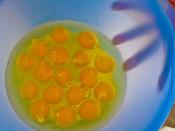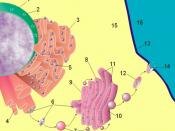Living cells are always categorized into two specific types of cells which are the eukaryotic and prokaryotic cells. The entanglement of a structure is the only major difference between the two. It is this structure that will drive its function and this structure which will account for the boundless assortment of life.
This week I will be discussing the bacterial cells: Plasma membrane and the Ribosome along with organelles: Golgi apparatus and Mitochondria.
Plasma membranePlasma membrane is also referred to as Cytoplasmic membrane.
Physical aspect: A Plasma membrane looks like big plastic bag with tiny holes. The holes are there to let some things flow inward and some things to flow outward. The Plasma membrane stores all the fluids and cell parts inside the membrane and keeps anything of harm out.
Composition: The Plasma membrane is not a solid piece; it is actually made up of pieces called phospholipids and proteins.
The composition is made up of a percentage of 40 and a percentage of 60 in lipids and proteins respectively. The lipids are what make up this "bag" and the proteins usually hang out around the "holes" to perform the processes that allow molecules in and out. The way the proteins and lipids are arranged is called the fluid mosaic model. In that model are phospholipids that look like heads and tails. The heads like water and the tails do not. The tails rub against each other and the heads face outward toward the watery area surrounding the cell. The two layers are called the bilayer. The proteins float inside the bilayer. Some are inside and some are outside the cell itself, while even more pass through with ends inside and out simultaneously. The proteins that pass through are part of active transport of molecules and ions.
Survival? These...


